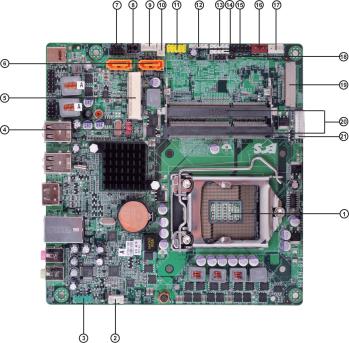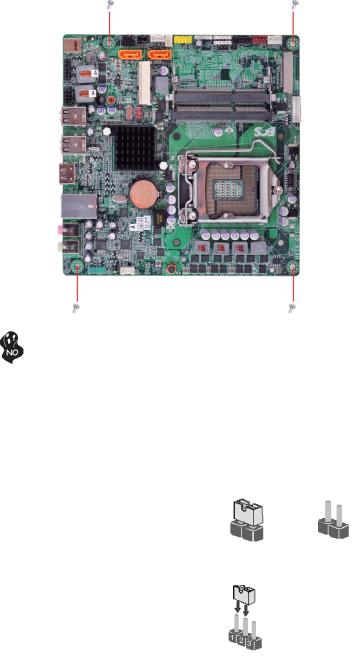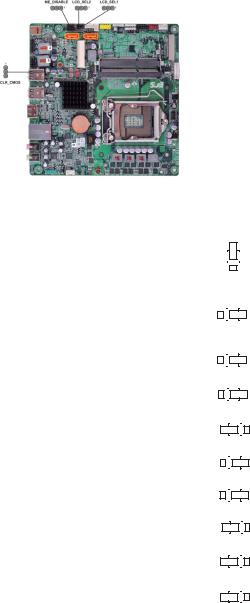Elitegroup H61H-G11 User Manual V1.0
Preface
Copyright
This publication, including all photographs, illustrations and software, is protected under international copyright laws, with all rights reserved. Neither this manual, nor any of the material contained herein, may be reproduced without written consent of the author.
Version 1.0A
Disclaimer
The information in this document is subject to change without notice. The manufacturer makes no representations or warranties with respect to the contents hereof and specifically disclaims any implied warranties of merchantability or fitness for any particular purpose. The manufacturer reserves the right to revise this publication and to make changes from time to time in the content hereof without obligation of the manufacturer to notify any person of such revision or changes.
TrademarkRecognition
Microsoft, MS-DOS and Windows are registered trademarks of Microsoft Corp.
MMX, Pentium, Pentium-II, Pentium-III, Celeron are registered trademarks of Intel Corporation.
Other product names used in this manual are the properties of their respective owners and are acknowledged.
FederalCommunicationsCommission(FCC)
This equipment has been tested and found to comply with the limits for a Class B digital device, pursuant to Part 15 of the FCC Rules. These limits are designed to provide reasonable protection against harmful interference in a residential installation. This equipment generates, uses, and can radiate radio frequency energy and, if not installed and used in accordance with the instructions, may cause harmful interference to radio communications. However, there is no guarantee that interference will not occur in a particular installation. If this equipment does cause harmful interference to radio or television reception, which can be determined by turning the equipment off and on, the user is encouraged to try to correct the interference by one or more of the following measures:
•Reorient or relocate the receiving antenna
•Increase the separation between the equipment and the receiver
•Connect the equipment onto an outlet on a circuit different from that to which the receiver is connected
•Consult the dealer or an experienced radio/TV technician for help
Shielded interconnect cables and a shielded AC power cable must be employed with this equipment to ensure compliance with the pertinent RF emission limits governing this device. Changes or modifications not expressly approved by the system’s manufacturer could void the user’s authority to operate the equipment.
Preface
ii
Declaration of Conformity
This device complies with part 15 of the FCC rules. Operation is subject to the following conditions:
•This device may not cause harmful interference.
•This device must accept any interference received, including interference that may cause undesired operation.
CanadianDepartmentofCommunications
This class B digital apparatus meets all requirements of the Canadian Interferencecausing Equipment Regulations.
Cet appareil numérique de la classe B respecte toutes les exigences du Réglement sur le matériel brouilieur du Canada.
AbouttheManual
The manual consists of the following:
Chapter 1
Introducing the Motherboard
Chapter 2
Installing the Motherboard
Chapter 3
Using BIOS
Chapter 4
Using the Motherboard Software
Chapter 5
Trouble Shooting
Describes features of the motherboard.
Go to H page 1
Describes installation of motherboard components.
Go to H page 7
Provides information on using the BIOS Setup Utility.
Go to |
H page 23 |
Describes the motherboard software
Go to |
H page 41 |
Provides basic trouble shooting tips
Go to |
H page 45 |
Preface

iii
TABLE OF CONTENTS |
|
Preface |
i |
Chapter 1 |
1 |
IntroducingtheMotherboard |
1 |
Introduction................................................................................... |
1 |
Feature............................................................................................ |
2 |
Specifications................................................................................ |
4 |
Motherboard Components.......................................................... |
5 |
Chapter 2 |
7 |
Installing the Motherboard |
7 |
Safety Precautions............................................................................ |
7 |
Choosing a Computer Case............................................................. |
7 |
Installing the Motherboard in a Case............................................ |
7 |
CheckingJumperSettings............................................................... |
8 |
Setting Jumpers..................................................................... |
...8 |
Checking Jumper Settings...................................................... |
..9 |
Jumper Settings...................................................................... |
..9 |
Installing Hardware................................................................... |
10 |
Installing the Processor.......................................................... |
10 |
Installing Memory Modules................................................... |
12 |
Expansion Slots...................................................................... |
14 |
Connecting Optional Devices................................................. |
15 |
Installing a SATA Hard Drive................................................ |
18 |
Connecting I/O Devices............................................................... |
19 |
Connecting Case Components..................................................... |
20 |
Front Panel Header................................................................ |
22 |
Chapter 3 |
23 |
Using BIOS |
23 |
AbouttheSetupUtility................................................................. |
23 |
The Standard Configuration........................ ........................... |
23 |
Entering the Setup Utilities...................................................... |
23 |
Resetting the Default CMOS Values.................................... |
24 |
UsingBIOS...................................................................................... |
24 |
BIOS Navigation Keys........................................................... |
25 |
Main Menu............................................................................. |
25 |
Advanced Menu...................................................................... |
26 |
Chipset Menu.......................................................................... |
34 |
iv
Boot Menu.............................................................................. |
37 |
Security Menu........................................................................ |
38 |
Exit Menu................................................................................ |
39 |
Updating the BIOS.................................................................. |
40 |
Chapter 4 |
41 |
UsingtheMotherboardSoftware |
41 |
AbouttheSoftwareDVD-ROM/CD-ROM................................... |
41 |
Auto-installingunderWindowsXP/Vista/7.................................. |
41 |
Running Setup......................................................................... |
42 |
ManualInstallation........................................................................... |
44 |
UtilitySoftwareReference................................................................. |
44 |
Chapter 5 |
45 |
Trouble Shooting |
45 |
Start up problems during assembly.............................................. |
45 |
Start up problems after prolong use............................................ |
46 |
Maintenanceandcaretips.............................................................. |
46 |
BasicTroubleshootingFlowchart................................................... |
47 |

1
Chapter 1
IntroducingtheMotherboard
Introduction
Thank you for choosing the H61H-G11 motherboard. This motherboard is a high performance, enhanced function motherboard designed to support the LGA1155 socket for Intel→ 2nd/3rd Generation CoreTM processors for high-end business or personal desktop markets.
This motherboard is based on Intel→ H61 Express Chipset for best desktop platform solution. H61 is a single-chip, highly integrated, high performance Hyper-Threading peripheral controller, unmatched by any other single chip-device controller. This motherboard supports up to 8 GB of system memory with dual channel DDR3 1333/ 1066 SO-DIMM. One Mini PCI Express slot is supported, which supports half-card. It implements an EHCI (Enhanced Host Controller Interface) compliant interface that provides six USB 2.0 ports (four USB 2.0 ports at the back panel and one USB 2.0 header support additional two USB 2.0 ports).
The motherboard is equipped with advanced full set of I/O ports in the rear panel, including one HDMI port, one DC-IN port, one Lan port, four USB 2.0 ports, and audio jacks for microphone and line-out.
In addition, this motherboard supports two SATA 3.0Gb/s connectors for expansion.
IntroducingtheMotherboard
2
Feature
Processor
The motherboard uses a LGA1155 type of socket that carries the following features:
• Accommodates Intel® 2nd/3rd Generation CoreTM processors
•Supports “Hyper-Threading” technology CPU
“Hyper-Threading” technology enables the operating system into thinking it’s hooked up to two processors, allowing two threads to be run in parallel, both on separate “logical” processors within the same physical processor.
Chipset
The Intel® H61 Chipset is a single-chip with proven reliability and performance.
•Support one Mini PCI Express slot (supports half-card)
•Integrated two SATA 3.0 Gb/s Host Controller
•Six USB 2.0 ports supported
•Serial Peripheral Interface (SPI) support
•Integrated Graphics Support with PAVP 1.5
•Intel® High Definition Audio Controller
Memory
•Supports DDR3 1333/1066 DDR3 SO-DIMM with Dual-channel architecture
•Accommodates two unbuffered SO-DIMMs
•Up to 4 GB per SO-DIMM with maximum memory size up to 8 GB
Audio
•5.1+2 Channel High Definition Audio Codec
•Meets Microsoft WLP3.x (Windows Logo Program) audio requirements
•All DACs supports 44.1k/48k/96k/192kHz sample rate
•Software selectable 2.5V/3.2V/4.0V VREFOUT
•Direct Sound 3D. compatible
•Power Support: Digital: 3.3V; Analog: 5.0V
IntroducingtheMotherboard

3
Giga LAN (Optional)
The onboard LAN provides the following features:
•Supports PCI ExpressTM 1.1
•Integrated 10/100/1000 transceiver
•Wake-on-LAN and remote wake-up support
Expansion Options
The motherboard comes with the following expansion options:
•One Mini PCI Express slot (supports half-card)
•Two SATA 3.0 Gb/s connectors
Integrated I/O
The motherboard has a full set of I/O ports and connectors:
•One LAN port
•One HDMI port
•Four USB 2.0 ports
•One DC-IN port
•Audio jacks for microphone and line-out
BIOS Firmware
This motherboard uses AMI BIOS that enables users to configure many system features including the following:
•Power management
•Wake-up alarms
•CPU parameters
•CPU and memory timing
•Graphic parameters
The firmware can also be used to set parameters for different processor clock speeds.
1.Some hardware specifications and software items are subject to change without prior notice.
2.Due to chipset limitation, we recommend that motherboard be operated in the ambiance between 0 and 50 ° C.
IntroducingtheMotherboard
4
Specifications
CPU |
• |
LGA1155 socket for Intel→ 2nd/3rd Generation CoreTM proces- |
||
|
|
sors |
||
|
• |
Supports “Hyper-Threading” technology CPU |
||
|
• |
DMI 2.0GT/s |
||
|
|
|
|
|
Chipset |
• |
Intel→ H61 Chipset |
|
|
Memory |
• |
Dual-channel DDR3 memory architecture |
||
|
• |
2 |
x 240-pin DDR3 SO-DIMM sockets support up to 8 GB |
|
|
• |
Supports 1333/1066 DDR3 SO-DIMM |
||
|
|
|
|
|
Expansion Slot |
• |
1 |
x Mini PCI Express slot (supports half-card) |
|
|
|
|
||
Storage |
• |
Supported by Intel→ H61 Express Chipset |
|
|
|
|
- SATA * 2 3.0 Gb/s devices |
|
|
Audio |
• |
Realtek ALC662GR 5-Ch High Definition audio CODEC |
||
|
|
|
|
|
LAN |
• |
Realtek 8111E Giga Lan |
||
|
|
|
|
|
Rear Panel I/O |
• |
4 |
x USB 2.0 ports |
|
|
• |
1 |
x DC-IN port |
|
|
• |
1 |
x HDMI port |
|
|
• |
1 |
x RJ45 LAN connector |
|
|
• |
2 |
x Audio port (microphone in, line out) |
|
|
|
|
|
|
Internal I/O |
• |
1 |
x 4-pin CPU_FAN connector |
|
Connectors & |
• |
1 |
x 4-pin SYS_FAN connector |
|
Headers |
• |
1 |
x Front panel audio header |
|
|
• |
1 |
x Front panel switch/LED header |
|
|
• |
1 |
x Speaker header |
|
|
• |
2 |
x Serial SATA 3.0 Gb/s connectors |
|
|
• |
1 |
x USB 2.0 header support additional two USB 2.0 ports |
|
|
• |
1 x Clear CMOS header |
||
|
• |
1 |
x LVDS connector |
|
|
• |
1 |
x Inverter/converter |
|
|
• |
1 x ME_UNLOCK header |
||
|
|
|
|
|
System BIOS |
• |
AMI BIOS with 32Mb SPI Flash ROM |
||
|
• |
Supports Plug and Play, STR (S3)/STD (S4) |
||
|
• |
Hardware monitor, Multi Boot |
||
|
• |
Supports ACPI & DMI |
||
|
• |
Audio, LAN, can be disabled in BIOS |
||
|
|
|
|
|
Form Factor |
• |
Thin Mini-ITX Size, 170mm x 170mm |
||
IntroducingtheMotherboard

5
Motherboard Components
IntroducingtheMotherboard

6
Table of Motherboard Components
LABEL |
COMPONENTS |
||
1. CPU Socket |
LGA1155 socket for Intel® 2nd/3rd Generation |
||
CoreTM Processors |
|||
|
|
||
2. SPEAKER |
Speaker header |
||
3. F_AUDIO |
Front panel audio header |
||
4. CLR_CMOS |
Clear CMOS jumper |
||
5. MINI-PCIE1X |
Mini PCI Express x1 slot (supports half-card) |
||
6. SATA1~2 |
Serial ATA 3.0 Gb/s connectors |
||
7. LCD_SEL1~2 |
LCD select jumpers |
||
8. ME_DISABLE |
ME disable jumper |
||
9. HDD_PW |
HDD power connector |
||
10. ODD_PW |
ODD power connector |
||
11. |
F_USB1 |
Front panel USB 2.0 header |
|
12. |
TS |
Touch board header |
|
13. CAMERA |
CCD header |
||
14. |
MCR |
Card reader header |
|
15. |
F_PANEL |
Front panel switch/LED header |
|
16. |
SYS_FAN |
3-pin system cooling fan connector |
|
17. |
CPU_FAN |
4-pin CPU cooling fan connector |
|
18. LCD_OFF |
Panel switch |
||
19. |
LVDS |
LVDS header (optional) |
|
20. SO-DIMM1~2 |
240-pin DDR3 SO-DIMM sockets |
||
21. FPD |
FPD power connector |
||
|
|
|
|
This concludes Chapter 1. The next chapter explains how to install the motherboard.
IntroducingtheMotherboard

7
Chapter 2
InstallingtheMotherboard
Safety Precautions
•Follow these safety precautions when installing the motherboard
•Wear a grounding strap attached to a grounded device to avoid damage from static electricity
•Discharge static electricity by touching the metal case of a safely grounded object before working on the motherboard
•Leave components in the static-proof bags they came in
•Hold all circuit boards by the edges. Do not bend circuit boards
Choosing a Computer Case
There are many types of computer cases on the market. The motherboard complies with the specifications for the Thin Mini ITX system case. Some features on the motherboard are implemented by cabling connectors on the motherboard to indicators and switches on the system case. Make sure that your case supports all the features required.
Most cases have a choice of I/O templates in the rear panel. Make sure that the I/O template in the case matches the I/O ports installed on the rear edge of the motherboard.
This motherboard carries a Thin Mini ITX form factor of 170 x 170 mm. Choose a case that accommodates this form factor.
Installing the Motherboard in a Case
Refer to the following illustration and instructions for installing the motherboard in a case.
Most system cases have mounting brackets installed in the case, which correspond the holes in the motherboard. Place the motherboard over the mounting brackets and secure the motherboard onto the mounting brackets with screws.
Ensure that your case has an I/O template that supports the I/O ports and expansion slots on your motherboard.
InstallingtheMotherboard

8
Do not over-tighten the screws as this can stress the motherboard.
Checking Jumper Settings
This section explains how to set jumpers for correct configuration of the motherboard.
Setting Jumpers
Use the motherboard jumpers to set system configuration options. Jumpers with more than one pin are numbered. When setting the jumpers, ensure that the jumper caps are placed on the correct pins.
The illustrations show a 2-pin jumper. When |
|
|
|
the jumper cap is placed on both pins, the |
|
|
|
jumper is SHORT. If you remove the jumper |
|
|
|
cap, or place the jumper cap on just one pin, |
SHORT |
OPEN |
|
the jumper is OPEN. |
|||
|
|
This illustration shows a 3-pin jumper. Pins 1 and 2 are SHORT.
InstallingtheMotherboard

9
Checking Jumper Settings
The following illustration shows the location of the motherboard jumpers. Pin 1 is labeled.
Jumper Settings
Jumper |
Type |
Description |
Setting (default) |
|
|
|
|
|
|
|
|
|
|
|
|
|
|
|
|
|
|
|
|
|
|
|
|
|
|
|
1-2: NORMAL |
1 |
|
|
|
|
|
|
|
||
CLR_CMOS |
3-pin |
Clear CMOS |
2-3: CLEAR |
|
|
|
|
|
|
|
|
|
|
|
|
|
|
|
|
|
|
|
|||||
|
|
|
|
|
|
|
|
|
|||||
Before clearing the |
|
|
|
|
|
|
|
|
|
||||
|
|
|
CMOS, make sure to |
|
|
|
|
|
|
|
|
|
|
|
|
|
CLR_CMOS |
||||||||||
|
|
|
turn off the system. |
||||||||||
|
|
|
|
|
|
|
|
|
|
|
|
||
|
|
|
|
|
|
|
|
|
|
|
|
||
ME_DISABLE |
3-pin |
Disable ME |
1-2: ME ENABLE |
|
|
|
1 |
||||||
|
|
|
|||||||||||
|
|
|
|
|
|
|
|
|
|
||||
2-3: ME DISABLE |
ME_ENABLE |
||||||||||||
|
|
|
|||||||||||
|
|
|
|
|
|
|
|
|
|
|
|
||
LCD_SEL1 |
|
|
1-2: 21.5’’ AUO |
|
|
|
1 |
||||||
|
|
|
|
|
|||||||||
|
|
M215HW03 |
|
|
|
|
|
|
|
|
|
||
3-pin |
SELECT LCD |
LCD_SEL1 |
|||||||||||
|
|||||||||||||
|
|
|
|
|
|
|
|
|
|
|
|||
LCD_SEL2 |
|
|
1-2: 21.5’’ AUO |
|
|
|
|
1 |
|||||
|
|
|
|
|
|
||||||||
|
|
|
|
|
|
||||||||
|
|
M215HW03 |
LCD_SEL2 |
||||||||||
|
|
|
|||||||||||
LCD_SEL1 |
|
|
2-3: 21.5’’ CPT |
|
|
|
|
|
|
|
1 |
||
|
|
|
|
|
|
|
|
|
|||||
|
|
|
|
|
|
|
|
|
|
|
|
||
3-pin |
SELECT LCD |
CLAA215FAO4 |
LCD_SEL1 |
||||||||||
|
|||||||||||||
LCD_SEL2 |
1-2: 21.5’’ CPT |
|
|
|
|
|
|
1 |
|||||
|
|
|
|
|
|
|
|
||||||
|
|
CLAA215FAO4 |
|
|
|
|
|
|
|
|
|
||
|
|
LCD_SEL2 |
|||||||||||
|
|
|
|||||||||||
LCD_SEL1 |
|
|
1-2: 21.5’’ BOE |
|
|
|
|
|
1 |
||||
|
|
|
|
|
|
|
|||||||
|
|
HT215F01-100 |
|
|
|
|
|
|
|
|
|
||
3-pin |
SELECT LCD |
LCD_SEL1 |
|||||||||||
|
|||||||||||||
LCD_SEL2 |
2-3: 21.5’’ BOE |
|
|
|
|
|
|
|
|
1 |
|||
|
|
|
|
|
|
|
|
|
|
||||
|
|
|
|
|
|
|
|
|
|
|
|
||
|
|
HT215F01-100 |
LCD_SEL2 |
||||||||||
|
|
|
|||||||||||
LCD_SEL1 |
|
|
2-3: 23.6’’ CMO |
|
|
|
|
|
|
1 |
|||
|
|
|
|
|
|
|
|
|
|||||
|
|
|
|
|
|
|
|
|
|
|
|
||
3-pin |
SELECT LCD |
M236HGE-L20 |
LCD_SEL1 |
||||||||||
|
|||||||||||||
|
|
|
|
|
|
|
|
|
|
|
|||
LCD_SEL2 |
2-3: 23.6’’ CMO |
|
|
|
|
|
|
|
1 |
||||
|
|
|
|
|
|
|
|
|
|||||
|
|
M236HGE-L20 |
|
|
|
|
|
|
|||||
|
|
|
LCD_SEL2 |
||||||||||
InstallingtheMotherboard

10
To avoid the system instability after clearing CMOS, we recommend users to enter the main BIOS setting page to “Load Default Settings” and then “Save and Exit Setup”.
Installing Hardware
Installing the Processor
Caution: When installing a CPU heatsink and cooling fan make sure that you DO NOT scratch the motherboard or any of the surface-mount resistors with the clip of the cooling fan. If the clip of the cooling fan scrapes across the motherboard, you may cause serious damage to the motherboard or its components.
On most motherboards, there are small surface-mount resistors near the processor socket, which may be damaged if the cooling fan is carelessly installed.
Avoid using cooling fans with sharp edges on the fan casing and the clips. Also, install the cooling fan in a well-lit work area so that you can clearly see the motherboard and processor socket.
Before installing the Processor
This motherboard automatically determines the CPU clock frequency and system bus frequency for the processor. You may be able to change the settings in the system Setup Utility. We strongly recommend that you do not over-clock processors or other components to run faster than their rated speed.
Warning:
1.Over-clocking components can adversely affect the reliability of the system and introduce errors into your system. Over-clocking can permanently damage the motherboard by generating excess heat in components that are run beyond the rated limits.
2.Always remove the AC power by unplugging the power cord from the power outlet before installing or removing the motherboard or other hardware components.
This motherboard has an LGA1155 socket. When choosing a processor, consider the performance requirements of the system. Performance is based on the processor design, the clock speed and system bus frequency of the processor, and the quantity of internal cache memory and external cache memory.
Fail-Safe Procedures for Over-clocking
When end-users encounter failure after attempting over-clocking, please take the following steps to recover from it.
1.Shut down the computer.
2.Press and hold the “Page Up Key (PgUp)” of the keyboard, and then boot the PC up.
3.Two seconds after the PC boots up, release the “Page Up Key (PgUp)”.
4.The BIOS returns to the default setting by itself.
InstallingtheMotherboard

11
CPU Installation Procedure
The following illustration shows CPU installation components.
A.Disengaging of the Load Lever
·Press the hook of lever down and pull it to the right side to release it from retention tab.
B.Opening of the Load Plate
·Lift the tail of the load lever.
·Rotate the load plate to fully open position.
C.Removing the Cap
·Be careful not to touch the contact at any time.
D.Inserting the Package
·Grasp the package. Ensure to grasp on the edge of the substrate.
·Make sure pin 1 indicator is on your bottom-left side.
·Aim at the socket and place the package carefully into the socket by purely vertical motion.
E.Closing the Load Plate
·Rotate the load plate onto the package IHS (Intergraded Heat Spreader).
·Engage the load lever while pressing down lightly onto the load plate.
·Secure the load lever with the hook under retention tab.
F.Fasten the cooling fan supporting base onto the CPU socket on the motherboard.
G.Make sure the CPU fan is plugged to the CPU fan connector. Please refer to the
CPU cooling fan user’s manual for more detail installation procedure.
InstallingtheMotherboard

12
1.To achieve better airflow rates and heat dissipation, we suggest that you use a high quality fan with 3800 rpm at least. CPU fan and heatsink installation procedures may vary with the type of CPU fan/ heatsink supplied. The form and size of fan/heatsink may also vary.
2.DO NOT remove the CPU cap from the socket before installing a CPU.
3.Return Material Authorization (RMA) requests will be accepted only if the motherboard comes with the cap on the LGA1155 socket.
Installing Memory Modules
This motherboard accommodates two memory modules. It can support two 240-pin DDR3 1333/1066 SDRAM. The total memory capacity is 8 GB.
DDR3 SDRAM memory module table
Memory module |
Memory Bus |
DDR3 1066 |
533 MHz |
DDR3 1333 |
667 MHz |
|
|
You must install at least one module in any of the two slots. Total memory capacity is 8 GB.
Do not remove any memory module from its antistatic packaging until you are ready to install it on the motherboard. Handle the modules only by their edges. Do not touch the components or metal parts. Always wear a grounding strap when you handle the modules.
Installation Procedure
Refer to the following to install the memory modules.
1This motherboard supports unbuffered DDR3 SDRAM .
2 |
Push the latches on each side of the SO-DIMM slot down. |
3 |
Align the memory module with the slot. The SO-DIMM slots are keyed |
|
with notches and the SO-DIMMs are keyed with cutouts so that they |
|
can only be installed correctly. |
4 |
Check that the cutouts on the SO-DIMM module edge connector match |
|
the notches in the SO-DIMM slot. |
5Install the SO-DIMM module into the slot and press it firmly down until it seats correctly. The slot latches are levered upwards and latch on to the edges of the SO-DIMM.
6Install any remaining SO-DIMM modules.
InstallingtheMotherboard
